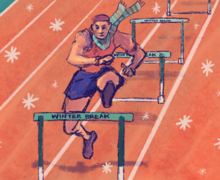Film Review: Sean Tucker wasn’t pleased with the play calls, so we evaluated the film
Elizabeth Billman | Senior Staff Photographer
Syracuse let go its offensive coordinator following a season-ending loss to Pittsburgh and questionable play calling.
Get the latest Syracuse news delivered right to your inbox.
Subscribe to our sports newsletter here.
Sean Tucker took to Twitter after Saturday’s loss against Pittsburgh, sharing his thoughts about his individual performance as well as the team’s, something he’s done after each game this season.
“I’m not pleased with the outcome of the game or the play calling,” Tucker tweeted. “I wanted to do so much more but I don’t call the plays.”
Tucker finished with a season-low 29 rushing yards against Pittsburgh’s rushing defense, which is ranked fifth nationally. Overall, the Orange only had 25 rushing yards with the one-two punch of Garrett Shrader and Tucker unable to get past the line of scrimmage on most of their 30 attempts because of struggles in the trenches.
A day after the loss, Syracuse announced it was parting with offensive coordinator and play caller Sterlin Gilbert, signalling a change in next season’s offense scheme, one that will likely be more tailored toward Shrader and Tucker’s abilities. Director of Athletics John Wildhack said the Orange need to improve their passing game, which will start with trying to find a new play caller who has experience developing quarterbacks to help Shrader.
“We need to throw the ball better and more effectively,” Wildhack said. “If we can do that and complement what Sean Tucker has done, we can have a very dynamic offense.”
With SU’s season in the books, here’s a look at Gilbert’s last time calling the plays for the Orange and the struggles against the Panthers’ defense:
The only time offense worked
With bowl eligibility on the line, Syracuse’s offense came out firing on all cylinders, establishing success in the run and pass games. In the red zone, SU scored by passing, the first time it did that since Damien Alford’s game-winning catch against Virginia Tech.
This play is one of the best designs the Orange had the entire day and might have been something they should’ve returned to later in the night. Shrader is in the backfield in an empty look, allowing him to either complete a quarterback draw with Maximilian Mang as his lead blocker or pass the ball to Courtney Jackson.
Since Pittsburgh fully commits to stop Shrader’s running abilities, the middle of the field is left mostly open. Shrader delivers a perfectly timed ball to Jackson in this run-pass option, putting the Orange on the board first.
Same play, different result
Syracuse never returned to the run-pass option that worked for Jackson’s score, instead trying to establish Tucker on a running back screen on multiple downs for the rest of the night. The Orange ran this play on their successful first drive to set up a fourth-and-2, which they were able to complete with an out route similar to what the Kansas City Chiefs do with Tyreek Hill.
But the unique play calling is something the Orange mostly saved for fourth down. With a third-and-long at the end of the first quarter, Syracuse ran the running back screen again, putting Tucker on the other side than the first time SU ran it.
The Panthers bring up an extra player to the line of scrimmage, faking a blitz from another linebacker. After seeing this, the Orange should’ve changed the play call immediately, but they stuck with it.
And after the snap, Pittsburgh runs stunts at the defensive line, which messes up the setup even more, not allowing Airon Servais to go up and lead block for Tucker. Instead of a positive gain, Shrader is wrapped up by two Pitt defenders as he’s looking to see if Tucker was open.
Bad design
On all the deep passing plays Syracuse had during the game, and throughout the entire season, the Orange rarely had their receivers run intermediate or short routes to give the quarterback an option to quickly pass to in case the pressure is too much — which it was on this play. Usually Tucker is the dump off guy, but when blitzes come he needs to pick them up instead, leaving no player short for Shrader.
After seeing no open receivers, Shrader rolls out to his right, leaving him to either take the safety or throw the ball out of bounds. But while Shrader is scrambling away from the pocket — which is something he has to do on most plays — Jackson or another receiver should run a simple slant or in route.
This was something that could have been an easy in-game addition as Pittsburgh left the middle of the field wide-open on every play, knowing the Orange would never send any short routes on a third-and-long.
The Panthers gave the Orange a lot of opportunities to beat them in the pass game, which they only took advantage of a couple of times. The answer to fixing the passing struggles was simple for Babers after the Pitt loss.
“We need to go back and rebuild,” Babers said about the passing game.
One last note, unnecessary trickery
Following a double pass that resulted in an underthrown ball by Sharod Johnson to Jackson, the Orange ran a direct snap to Tucker on this play. While this makes it a sort of QB keeper, with Tucker in Shrader’s position, the play call leaves no read option in case Tucker’s running lane is clogged. And it was completely clogged.
This play’s design leaves the gain in the hands of left tackle Matthew Bergeron, who’s pulling from the other side of the field to give Tucker a lane. Bergeron is able to get in front of Pittsburgh Linebacker Phil Campbell III, but he doesn’t finish his block. Tucker now has no space to work with.
“There wasn’t a lot of room for Sean. The linebackers were downhill,” Babers said after the game.
Also, Alford was instructed to go inside to try and block, instead of getting the defensive back in front of him. But with the placement of the ball on the right hash, the field is small enough for cornerback A.J. Woods to make a play. Woods does just that by finishing Campbell’s tackle, sending Tucker down to the ground 4 yards in the backfield.
Published on November 29, 2021 at 9:58 pm
Contact Anish: asvasude@syr.edu | @anish_vasu






